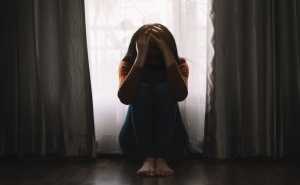Taking the Measure of Mental Health in a Pandemic

The disruptions from the COVID-19 pandemic are far from over.
Financial hardships, fear of infection, and continued social isolation continue to take a toll on the mental health of Americans.
In March, to better understand and measure mental health distress, a working group in the Bloomberg School’s Department of Mental Health undertook research to assess the mental health impact of the pandemic over time through the inclusion of key questions in existing and nationally representative domestic and international surveys.
Nearly six months into the COVID-19 crisis, survey data have yielded insights regarding traditional and social media’s impacts on mental health and the pandemic’s psychological effects on people with no history of mental illness. Here, researchers share some initial findings from the ongoing projects.
Social media and traditional media exposure are associated with mental health distress
A study published online July 10, 2020, in the American Journal of Preventive Medicine found that greater exposure to social and/or traditional media sources is associated with mental distress among U.S. adults ages 18 and older.
Researchers analyzed nationally representative data from 6,329 adults who completed the Understanding America Survey between March 10-31, 2020.
The survey fielded questions about how frequently respondents had experienced feelings of mental distress, including anxiety, depression, and hopelessness, in the two weeks preceding the survey. Researchers also sought data on the amount of time spent on social and traditional media and the news sources they turned to for information about the pandemic.
Among the findings:
- For every one-hour increase in time spent on social media and each traditional media source consulted, there was a modest increase in mental distress.
- Time spent on social media per day increased from an average of 50.4 minutes to 76.2 minutes between March 10-31.
- The number of traditional media sources consulted increased from an average of 2.38 to 3 between March 10-31.
- Associations with mental distress in relation to media did not differ among individuals with or without a history of depressive symptoms.
“These results do not mean that people should stop using social media or restricting media intake,” says Kira Riehm, MSc, a PhD candidate in Mental Health and the study’s lead author. “Rather, individuals should be thoughtful when engaging in information-seeking, and should consult public health sources that disseminate evidence-based information, wherever possible.”
Assistant professor Johannes Thrul, PhD, the study’s senior author, adds: “There is evidence from other studies that interactions on social media are beneficial for your mental health. If you are spending time on social media, limit it to activities that will be most supportive of your mental health, such as engaging with friends and family.”
Individuals with no history of mental health conditions are at risk for mental distress during the pandemic.
More than one in four U.S. adults with no prior history of a mental health condition experienced mental distress in the early phases of the pandemic, according to research from the mental health working group.
Published online August 3, 2020, in Preventive Medicine, the study analyzed 9,687 survey responses from the Pew Research Center’s American Trends Panel, a nationally representative online survey panel, from March 19-24, 2020.
The survey questioned participants about how frequently they felt nervous, anxious, depressed, lonely, had trouble sleeping, and whether they had physical reactions to stress in the week prior to taking the survey. The survey also gathered information about individuals’ behavior, perceptions, and experiences in the pandemic’s early days.
Among the findings:
- 15 percent experienced two psychological distress symptoms—including anxiety, depression, loneliness, and sleep difficulties—for at least three days in the week the survey was completed.
- 13 percent reported three or more psychological distress symptoms.
- The most common symptoms of psychological distress experienced for at least three days were nervousness, anxiety, or being on edge (average of 39 percent); sleeping difficulties (27 percent); depression (19 percent); and loneliness (15 percent).
- Searching online, posting about the coronavirus on social media, major changes to personal life, and a perception that the virus threatens the U.S. economy were all risk factors for more serious psychological distress.
- Demographics such as being female, never having been married, being divorced or separated, and having someone in the household with a pay cut or reduced hours were also risk factors for psychological distress.
- Attending religious services once a week on average prior to the pandemic was associated with lower distress.
“People with no prior mental health condition may not be well equipped to handle the onset of mental health symptoms, especially during a pandemic when traditional coping strategies aren’t available in the usual ways,” says Calliope Holingue, PhD, MPH, postdoctoral fellow in Mental Health at the Bloomberg School and in Neuropsychology at the Kennedy Krieger Institute. “Furthermore, people with no prior experience of seeking mental health treatment may not know how to navigate the mental health service system.”
Future studies will focus on mental distress in relation to geographic factors and chronic diseases, and changes in mental health and substance use.
- Variation of mental health distress across counties: Researchers are deploying a survey to examine predictors of county-level mental distress.
“One great benefit of this survey is the sample size is so large we can go down to the county level to look at area-level characteristics associated with mental distress, including the spread of the pandemic in that county, socioeconomic status, layoffs, existing resources, and more,” says Elizabeth Stuart, PhD, associate dean for Education and professor in Mental Health. - Changes in Mental Health and Substance Use Over Time: Separate studies on mental health and substance use are exploring changes in both areas over the course of the pandemic.
- Mental Distress and Chronic Health Conditions: Researchers will investigate the intersection of mental distress and a history of chronic health conditions during the pandemic.





